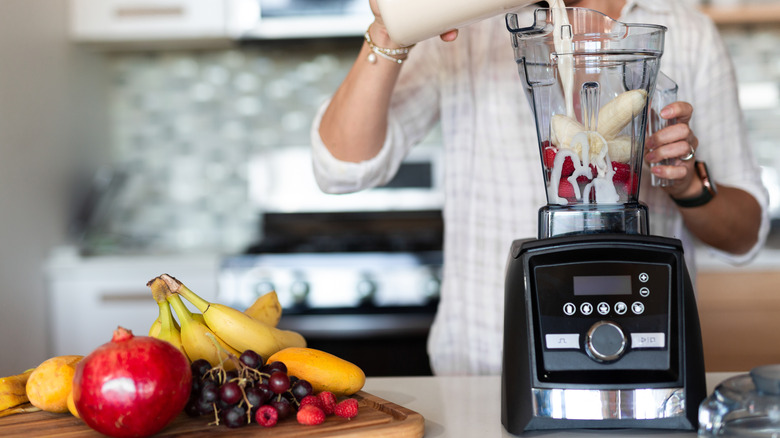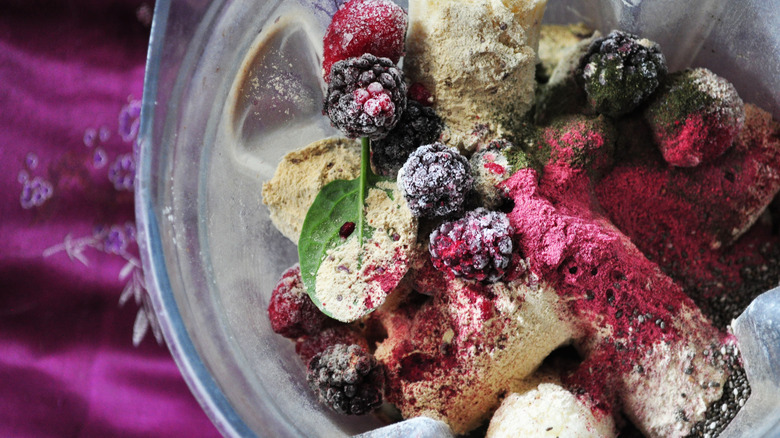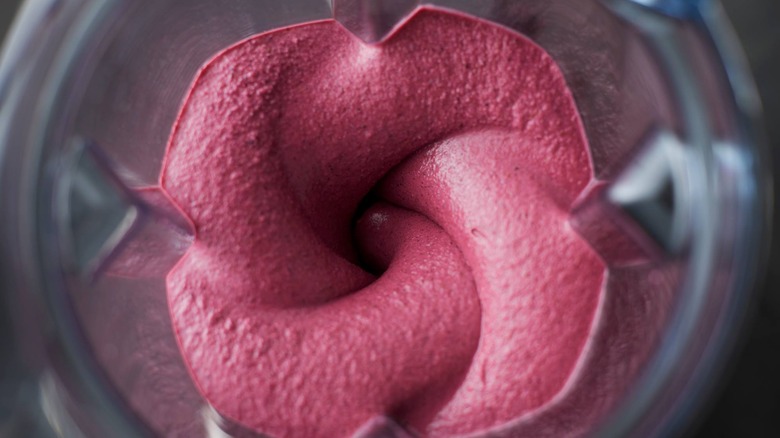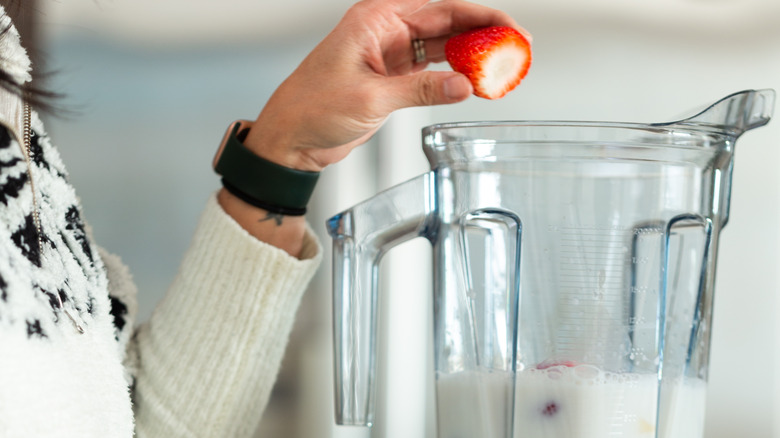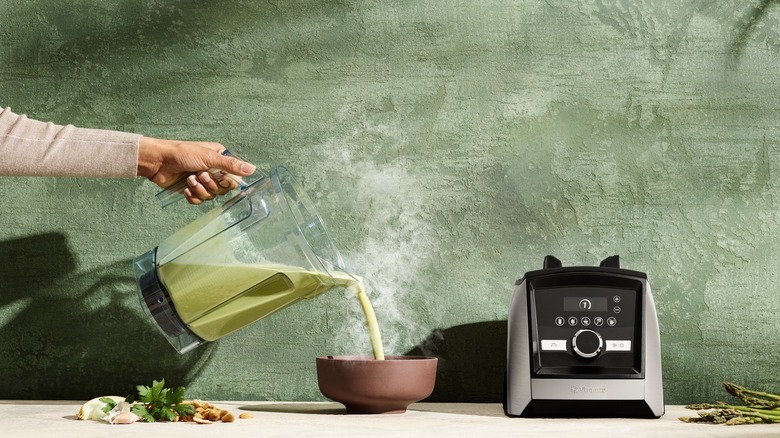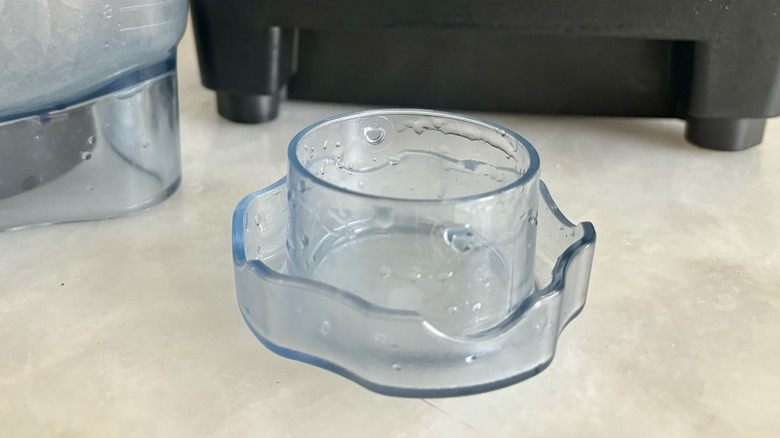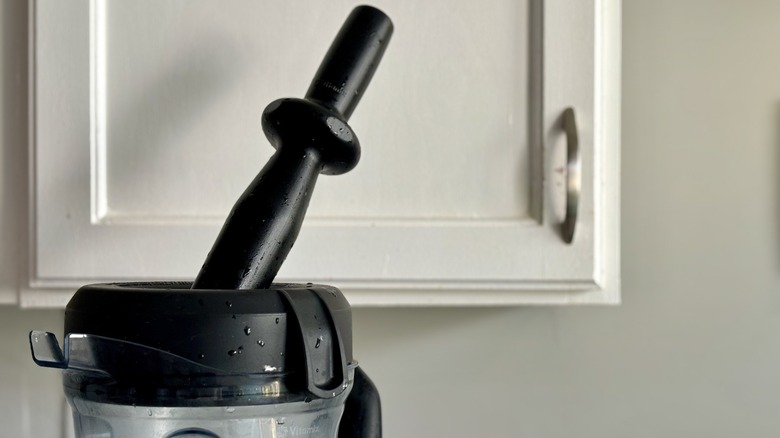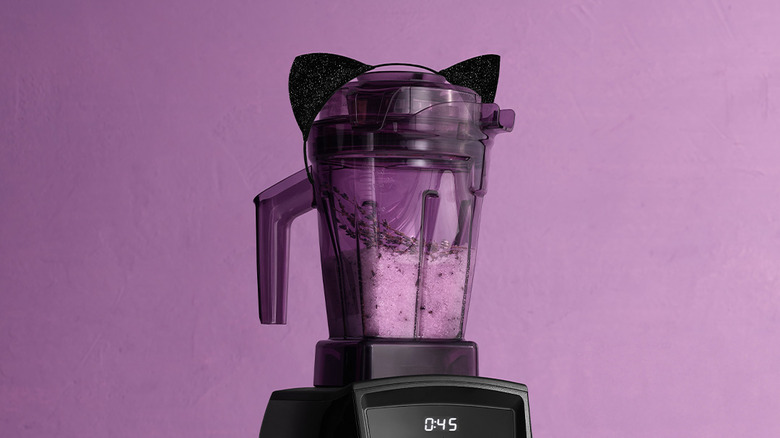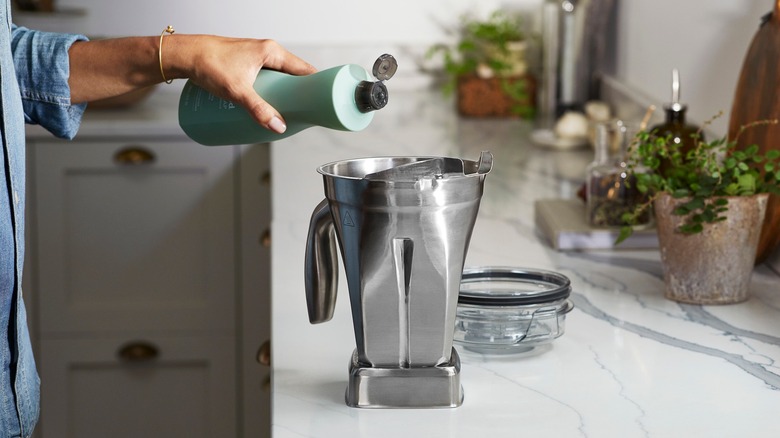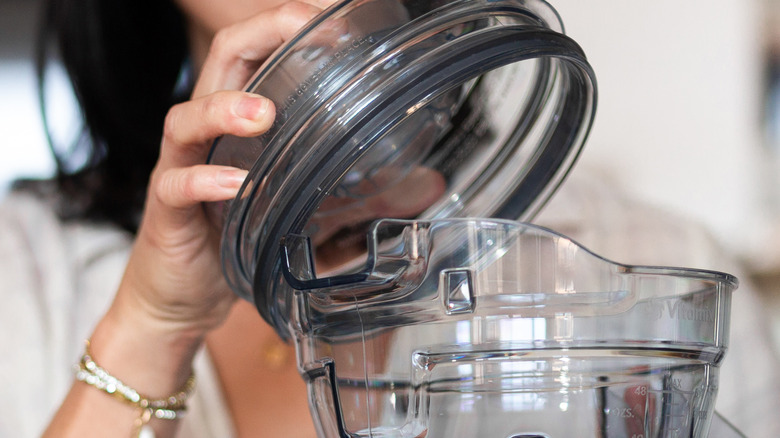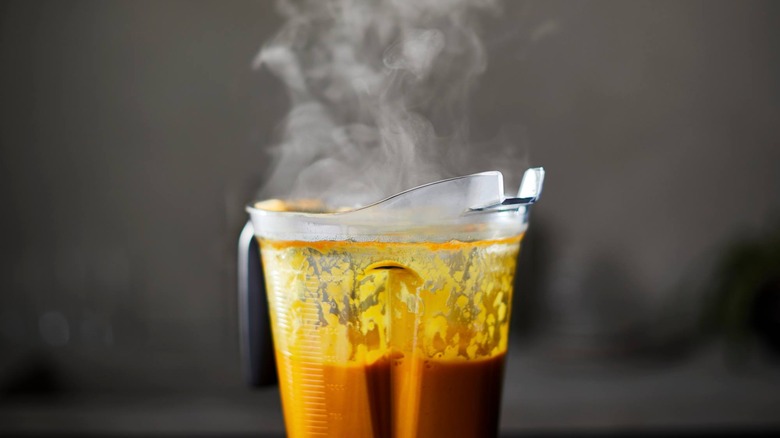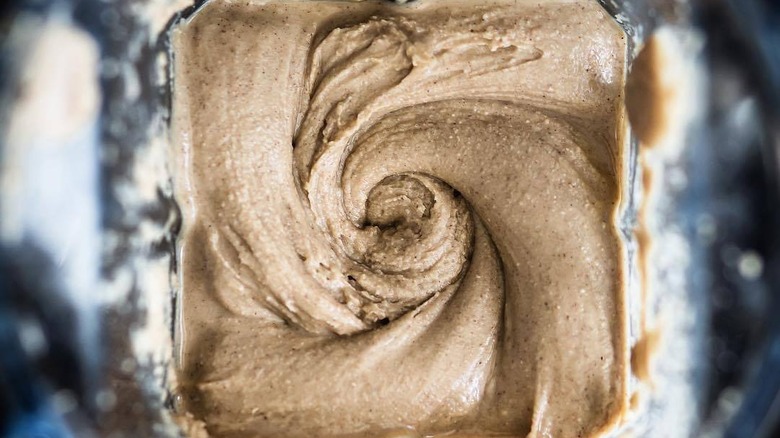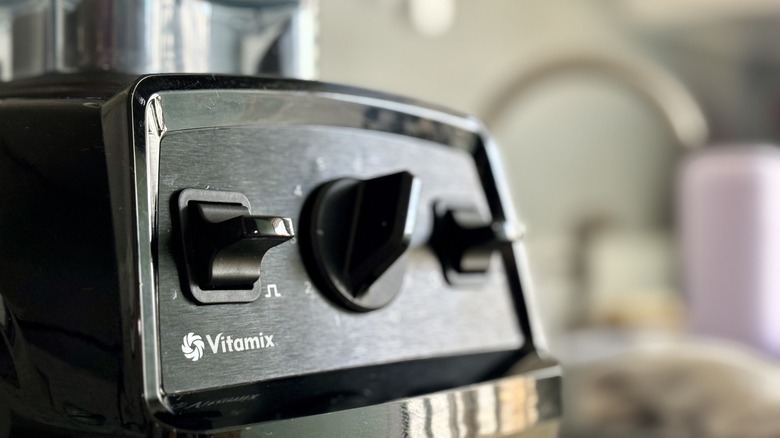14 Tips And Tricks For Using A Vitamix Blender
Vitamix has prioritized product quality since launching in 1921. After 100 years, four generations, and sales in 130 countries, Vitamix continuously ranks as one of the best blender brands. It's the preferred choice of blender in many professional kitchens due to its powerful motors, robust construction, and versatility. As the veil between the kitchen and the diner grows thinner, there is more interest in what chefs are doing and using in their workspaces. As a result, there is an uptick in the market for commercial kitchen equipment, and a sizable demand for it comes from home cooks.
The secret's been out about Vitamix for a while. But what's everyone raving about? Vitamixes are popular because they can do and handle a lot. However, many people want or have one, yet still don't know how to unlock its potential. In the professional kitchen, cooks quickly learn many ways to use the prophetic blender — ways that enable them to emulsify sauces, blitz toasted spices, and blend agar agar into large volumes of hot liquid. But what if you just want to make a smoothie? Well, there's a correct way to do that, too. In this quick guide, we take you through a whirlwind of blender techniques that will help you get the most out of your fancy Vitamix.
Loading queue matters
Vitamix has a message for you: heavy on the bottom, light on top. If you didn't know, there's a generally agreed-upon order in which your Vitamix blender should be loaded.Start with liquids like water and yogurt first, then go for dry goods like seasoning and powders. After that, pack on the leafy greens, followed by the vegetables and ice or anything frozen on top. It might sound silly, but it's not arbitrary. Placing the heavier stuff on top helps push the rest of the ingredients into the spinning blades. A stronger downward force into the Vitamix's blades also helps prevent cavitation, which is the formation of air bubbles around the blades that can cause the blender to stall. In general, the more downward force weighing on the blades, the higher the blender will perform.
If you're making a smoothie, Vitamix recommends not adding as much liquid as you might think, or at least not all of the liquid at once. Instead, add small amounts of your liquid ingredients first — enough to blend the solid ingredients smoothly — then, after processing for 10 to 20 seconds, adjust the consistency by adding more liquids to make the smoothie thinner or more solids to make it thicker.
Go 0 to 100
Except in a few specific cases — such as working with delicate or hot ingredients — you should aim to blend everything in your Vitamix on high. But don't just keep your blender knob taped to the highest setting. The best move is to start on the lowest setting and quickly but steadily work your way up to the highest. There are several mechanical and technical reasons for doing so. Gradually increasing the speed reduces the initial stress on the blender's motor. This is especially relevant for high-performance blenders like Vitamix, as it allows the motor to adapt to the resistance posed by the ingredients and will also help prevent it from overheating.
Starting slow for the first few seconds of the processing will help to prevent your beautiful mixture from splattering all over your kitchen, especially when dealing with liquids or fine ingredients. It allows the blades to engage with, or "grab," the ingredients without creating a mess. After you've got your blend going, quickly cranking it up to high speed will draw air into the motor to help keep it cool as it works. The less often you overheat your blender's motor, the longer life expectancy it will have.
Use the pitcher capacity to your advantage
Vitamixes were made to handle the toughest blend work and engineered to run optimally when filled to a certain level. In fact, Vitamix actually encourages its customers to take advantage of the up to 64-ounce capacity of its blenders. But why? Again, this is where weight is important when using your blender. The more ingredients piled on top of the blades at the bottom of the pitcher, the better they will work to pulverize everything inside. Blending at full capacity helps achieve consistent results across the entire batch. It ensures that all ingredients are evenly processed, producing a uniform texture in the final mixture.
Equally as important, using the full capacity of your Vitamix pitcher helps reduce the amount of batches needed to complete a recipe. Using up all that space will make an efficient use of your time and energy, as well as that of the blender. This is great news if you're cooking for a crowd of people or looking to bulk up on your meal prep for the week.
More is best
Believe it or not, Vitamix makes its blender blades blunt instead of razor-sharp. Instead of slicing, the Vitamix actually uses the motor, the blade's speed, and the shape of the container to pull the ingredients through the path of the blades. But there is one caveat: It needs full, constant coverage of the blades to be effective.
Blenders with sharp blades wear down over time, like any knife would, but it's not practical to sharpen them. The hardened stainless steel construction of the Vitamix's blades ensures longevity and resistance to wear, allowing the blades to withstand the high-speed blending of various ingredients over an extended period. But that's only when the blades are fully immersed in what they're blending. Vitamix blades are designed to perform more efficiently under high-friction conditions. So really, the more ingredients you use, the better. You can even fill your blender to capacity, process the batch, and add some extra into it.
Don't stop at smoothies
Most folks' minds jump straight to the smoothie when they think of what to use their blender for. And they're not wrong about it — your Vitamix can surely make a refreshing smoothie recipe in a snap. But you didn't spend a pretty penny to buy just a smoothie machine. Instead, let your Vitamix live up to its potential and mix things up a bit. According to the Vitamix website, most models have the capability to heat ingredients through friction, allowing you to make hot soups directly in the blender. You can use your blender for smoother hollandaise or whip up a perfect pesto for summery pasta. In addition, you can also save money on pricey nut butter and nut milk by making your own, and even grind seeds or grains in your Vitamix to make flours for baking.
The moral here is this: The Vitamix (and its high price tag) comes with a world of opportunity — and you get what you pay for. Make that mole negro from that Oaxacan cookbook you've been thinking about, or whip up a herb oil with that extra basil from the garden before it goes bad. The world is your blender.
The lid plug is a measuring cup
Here's an easy one. See that clear plastic plug sitting like a donut hole in the middle of your Vitamix's black rubber lid? Yeah, that one. Pull it out and flip it over. Bam! You've got yourself a tiny measuring cup. This comes in handy when you're in the middle of making a batch of frozen cocktails and realize you forgot to pull your jigger out to measure up a couple of shots of liquor. Or, maybe you're adding a little bit of a strong or concentrated liquid to a recipe, like ginger or wheatgrass juice. You can measure out as much liquid as you need without having to dirty another cup.
Removing the lid plug on your Vitamix also leaves a necessary hole for certain blending needs, such as adding ingredients during processing. For example, some batters and doughs require you to incrementally add your dry ingredients to the wet to prevent lumps. Keep your lid on while blending pancake batter to prevent any splattering, all while adding your dry ingredients through the hole. This hole is also what you will feed the tamper down into when necessary. You can also remove the plug to create a steam vent when blending hot ingredients to prevent pressure from building up.
If you got it, tamp it
You likely noticed your blender came with a bulky tamper. That long black stick that came with your Vitamix is a valuable tool that helps push ingredients into the blades for more efficient blending. This is especially helpful when working with thick or stubborn mixtures and tough ingredients. If you notice your Vitamix blender stalling or struggling to process ingredients, pull off the lid plug with the blender still running and stick the tamper in.
The tamper has two sides — one longer and one shorter — separated by a middle stopper piece. The shorter end is the handle, and the longer end is the one you'll want to stick into the blender. Push the tamper all the way down until it ends at the stopper, then rotate the tamper around in circles, pushing up against each of the four corners of the blender. This should eliminate any air bubbles around the blades and create a vortex for your blender to start moving again.
While we're on the note of things that are stuck: If you're having trouble pouring out thick or sticky mixtures from the pitcher, use a rubber spatula to scrape down the sides, corners, and under the blades to get every last bit of mixture. However, ensure you do this while the pitcher and blades are removed from the Vitamix base. You don't want to pulverize your rubber spatula or catch your fingers.
There's a container for that
All Vitamix blenders come with a standard pitcher that is designed to blend things into liquids. If you're thinking of using your Vitamix to blitz dry ingredients, you should consider buying a separate dry container. Though it's not cheap, a dry container is made to push, instead of pull, ingredients away from the blades, forcing them to disperse around the container to keep them from clumping together.The pitcher is also engineered to handle low ingredient capacity and is shaped like a tunnel to accommodate smaller batch sizes. This design is ideal for grinding or milling grains, kneading dough, making nut butters, milling spices, and chopping chocolate.
One of the best uses for your dry container is to grind black pepper. Grab your Vitamix, a china cap strainer, a big tray or pot, and some black peppercorns. Using the dry grains container, quickly blitz a cup or so of whole black peppercorns, quickly turning the speed from low to high, holding for a second or two, and then turning the Vitamix off. Dump the peppercorns out into the china cap and hold the sieve over the large container. Sift the peppercorns, hitting the side of the china cap with your free hand like a tambourine. The fine peppercorn dust will fall through the holes, and the coarse peppercorns will be left in the china cap.
Blend it to clean it
As if things couldn't get better, the Vitamix can clean itself. Well ... almost. Don't throw the pitcher in the dishwasher when you're done using your Vitamix. Otherwise, you risk leaving the plastic pitcher vulnerable to cracking under pressure and heat. There's also no need to go sticking your hand inside the pitcher to reach behind the blades. To clean, simply rinse the bulk of the mess out in the sink. Then, add water to the pitcher with a few drops of dish soap. Reattach the pitcher to the Vitamix base and run the blender on high for 30 to 60 seconds or until all the food particles have washed away from the sides of the container. Rinse again and, like magic, your blender's clean.
But wait — did something colorful, like annatto seed, stain the walls of your Vitamix? Try blending again with baking soda and a small amount of water, then scrub with a soft sponge. If the stains are still present, try using vinegar and baking soda to clear them up. Avoid using harsh chemicals like bleach, as they can wear away at the plastic parts of the Vitamix over time.
Don't be afraid to take your top off
Although Vitamix may not tell you to do this or even advise against it, you might need to blend some recipes with your lid off. As a disclaimer: Do this at your own risk. For most things you make in your Vitamix, you should keep the lid on.
Here's one case where you might want to remove the lid. Let's say you're making a very thick and herbaceous sauce with many fistfuls of cilantro and several cups of sesame tahini. The sauce needs to be smooth, but it also needs to retain the vibrant green color of the herbs you're using. You've got to run the Vitamix on low, otherwise you risk overheating the essential oils in the cilantro, turning the color of the sauce brown. But, with the blender running on low, the blades aren't making a vortex because of how thick the sauce is, and the tamper isn't dispersing the cavitation at such a low speed.
In this scenario, the only solution is to take the top off the blender and, using a small rubber spatula, carefully agitate the corners and sides of the pitcher to work the mixture into a steady vortex. While this trick works well with some experience and finesse, you always will run the risk of tearing apart your spatula and sending the liquid flying.
If it's hot, watch your speed
Steam means pressure, and agitating a bunch of steam inside of a whirring blender can lead to a disaster. Therefore, putting hot liquids in a blender, including your Vitamix, requires some precautions to ensure safety and prevent splattering. First, start with your blender at a cool room temperature. This will help cool the liquid down a bit as it enters the container.
Then, remove the lid plug to allow steam to escape during blending. Make sure the lid is on tight and, starting at a low speed, begin blending. Gradually increase the speed as needed to achieve the desired consistency, but keep your speed as low as possible. If needed, hold a folded-up kitchen towel over the hole to shield the palm of your hand from torrenting steam as it escapes through the top of the blender. Work in smaller batches — filling the pitcher up no more than halfway if possible — to reduce the risk of high pressure building up inside the blender.
Pour oil through the lid hole to make an easy emulsion
If you're looking to make an emulsion — the combination of two immiscible liquids, like oil and water — a Vitamix is your best friend. A vital part of making a proper emulsion is adding the oil to the water base gradually. If too much oil is added at once, the emulsion will not stabilize and will ultimately break.
Luckily, your Vitamix is made for this. There's a special hole in the lid made just for this sort of thing. First, add your water-based ingredients and seasonings to the pitcher and put the lid on without plugging it in. Start the blender on low and gradually pour the oil into the pitcher through the hole in a slow, steady stream to create a stable emulsion. Increase the speed a bit until a smooth, consistent emulsion forms. Taste, adjust your seasonings, and blend again until smooth. The creamiest vinaigrettes and the thickest, smoothest mayonnaise is at your fingertips with the flick of the lid plug.
Turn it down before you turn it off
It is best practice to always stop your Vitamix at the lowest speed. Lowering the speed before turning off the blender reduces the risk of sudden splattering or spills. This will allow the blades to gradually slow down instead of abruptly stopping, which could send air bubbles flying to the surface and cause your mixture to eject. Yikes!
Make sure the blades and motor of your Vitamix come to a complete stop before you remove the pitcher from the base. Otherwise you risk wearing out the blender's drive socket, and that's no fun to replace. Getting in the habit of turning the blender down low before turning it off will also remind you to start the blender on low if you're not already used to it. Nothing's more jarring for you — and for your blender — than plugging it in and being hit with a sudden violent whirring.
Buy refurbished
It's possible that you're really set on buying a Vitamix, but you're just really hard-pressed to shell out the big bucks for a blender. We get it — it's not a realistic cost for everyone. That said, make sure you consider a refurbished option before you negate the idea of Vitamix ownership altogether. Reconditioned Vitamix blenders are sold on the Vitamix website and the company's Amazon store at a lower price compared to brand-new units. An Amazon refurbished Vitamix Explorian model blender with a 64-ounce low-profile pitcher currently sells for less than $300 — which is a fraction of what a new Vitamix costs. When you buy refurbished, you maximize the blender's value and your purchasing power without sacrificing functionality or quality.
All certified reconditioned Vitamixes are done so by-hand in the United States and come with lifetime customer support. Plenty of online testimonials make the case that refurbished Vitamix blenders are as good as any new blender fresh from the factory. Plus, you can feel comfortable buying your products refurbished from Amazon because the lifetime customer support offer still applies to reconditioned appliances purchased through Vitamix's Amazon store. Everyone loves a good deal, and everybody could use a Vitamix, so this one's really a no-brainer.
